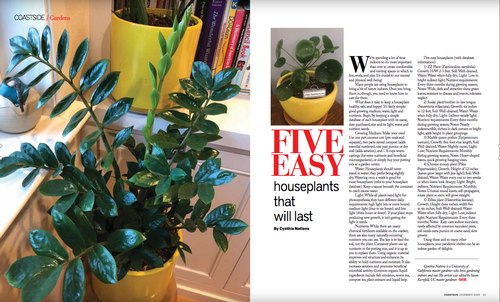We're spending a lot of time indoors so it's more important than ever to create comfortable and inviting spaces in which to live, work, and play. It's crucial to our mental and physical wellbeing! Many people are using houseplants to bring a bit of nature indoors. Once you bring them in, though, you need to know how to care for them.
What does it take to keep a houseplant healthy, safe, and happy? It's fairly simple: good growing medium, water, light, and nutrients. Begin by keeping a simple database of each houseplant with its name, date purchased, size, and its light, water, and nutrient needs.
Growing Medium: Make your own! Use 1 part coconut coir (pre-soak and separate), 2 parts sieved compost (adds essential nutrients), 1 part pumice or dry stall (adds aeration), and 1-1/2 cup worm castings (for extra nutrients and beneficial microorganisms), or simply buy your potting mix at a garden center.
Water: Houseplants should never stand in water; they prefer being slightly dry. Watering once a week is good for most houseplants (refer to your houseplant database). Keep a saucer beneath the container to catch excess water.
Light: While all plants need light for photosynthesis, they have different daily requirements: high light (6 or more hours); medium light (4-6 hours); and low light (3 hours or fewer). If your plant stops producing new growth, it isn't getting the light it needs.
Nutrients: While there are many chemical fertilizers available on the market, there are also many naturally occurring nutrients you can use. The key is to feed the soil, not the plant. Container plants use up nutrients in the potting mix, and it is up to you to replace them. Using organic material improves soil structure and enhances its ability to hold nutrients and moisture. It also increases aeration and promotes beneficial microbial activity. Common organic liquid ingredients include fish emulsion, worm tea, compost tea, plant extracts, and liquid kelp.
Five easy houseplants (with database information):
1) ZZ Plant (Zamioculcus zamifolia). Growth: H/W 2-3'; Soil: Well-drained; Water Needs: Water when fully dry; Light Needs: Low to bright indirect light; Nutrient Requirements: Every 3 months during growing season; Notes: Wide, dark and attractive shiny green leaves, resistant to disease and insects, tolerates neglect.
2) Snake Plant/Mother-in-Law Tongue (Sansevieriatrifasciata); Growth: 6”-12'; Soil: Well-drained; Water Needs: Water when fully dry; Light Needs: Indirect steady light; Nutrient Requirements: Every 3 months during growing season; Notes: Nearly indestructible, thrives in dark corners or bright light, adds height to plant groupings.
3) Marble Queen Pothos (Epipremnum aureum); Growth: 5' vine length; Soil: Well-drained; Water Needs: Slightly moist; Light Needs: Low; Nutrient Requirements: Monthly during growing season; Notes: Heart-shaped leaves, quick-growing hanging vines.
4) Chinese Money Plant (Pilea Pepermoides); Growth: H-12" (leaves grow larger with less light); Soil: Well-drained; Water Needs: Water every 1-2 weeks or when leaves look droopy; Light Needs: Bright, indirect; Nutrient Requirements: Monthly; Notes: Unusual round leaves, self-propagator, rotate plant so stem will grow straight.
5) Zebra Plant (Haworthia fasciata); Growth: H-3”; W-5-6”; Soil: Well-drained; Water Needs: Water when fully dry; Light Needs: Low, indirect light; Nutrient Requirements: Every 3 months; Notes: Easy-care indoor succulent, rarely affected by common succulent pests, soil needs extra pumice or coarse sand, slow grower.
Using these and so many other houseplants, your pandemic shelter can be an indoor garden of delights.
Cynthia Nations is a UC Master Gardener who loves gardening indoors and out. The article was edited by Susan Kornfeld, UC Master Gardener.
Attached Images:
